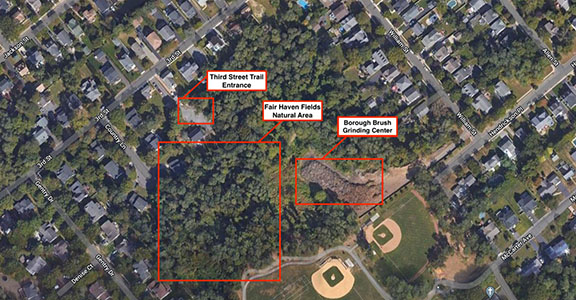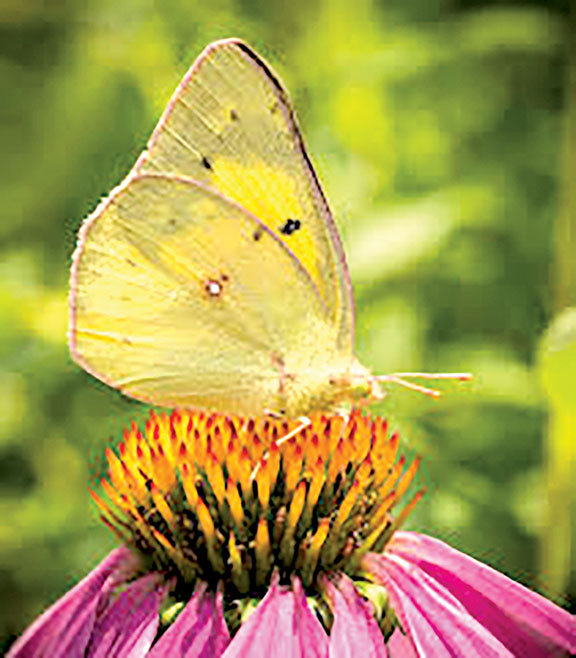
By Chris Rotolo
FAIR HAVEN – Has the installation of a new pollinator garden in the Fair Haven Fields Natural Area uncovered the former site of a historic agricultural nursery? During remarks to the governing body at its November meeting, Mark Olsen – a member of the natural area’s advisory committee for the borough – said that while he and a group of dedicated volunteers were planting trees in the area of a trail that connects Third Street to a set of baseball diamonds at Fair Haven Fields, they dug up something unexpected.
“When we got about (a half foot) down, we kept hitting chunks of asphalt and cement. I don’t know the full history of the area, but we think the site might have been Lovett’s Nursery,” Olsen said.
Agricultural History On The Peninsula
In 1877, John Thompson Lovett relocated to Monmouth County from Bucks County, Pennsylvania, where he sought work in Rumson with one of the leading nurseries in the state, A. Hance & Sons.
After six years with the successful Rumson operation, Lovett struck out on his own, leasing two small parcels of land on the Little Silver, Rumson and Fair Haven peninsula, where he began experimenting with fruits and vegetation.
In short time, Lovett’s Monmouth Nurseries became a national brand for small fruit production, supplying retailers like Sears Roebuck, Macy’s and the like, but his trailblazing efforts were not limited to small fruits and crops. Lovett also established a local printing press and became a pioneer in commercial outreach with the publication and distribution of full color product catalogues, as well as one of the first horticultural trade magazines “Orchard and Garden.”
Lovett would also become postmaster of Little Silver, taking the reins of a postal venture that was not only a public service to the peninsula region, but crucial to the growth of his own endeavors. That growth allowed Lovett’s Monmouth Nurseries to dramatically expand, leading to the purchase of the majority of Hance’s nursery and further land acquisitions in Colts Neck, Deal, Holm- del, Middletown and Fair Haven.
Building A Pollinator Garden
Though the asphalt and cement may very well hold historical significance, for the purposes of Olsen and the local volunteers, it makes the process of planting a series of shade trees an impossibility. Since the spring, the group has planted 50 trees in the natural area, but it was forced to alter the vision for the project due to the environment’s hardened underbelly.
Borough resident and Rumson Garden Club member Bonnie Torcivia was tapped to repurpose the area as a pollinator garden.
A pollinator garden is one that attracts natural pollinators, like bees, butterflies, hummingbirds, and other wildlife capable of transferring pollen from flower to flower. Torcivia told the council that, while trees would have a hard time taking root in the area, native plants that are already used to growing in the area would be a beneficial alternative.
“The local pollinators that have familiarity with these native plants are in crisis right now. Bees, butterflies, beetles and other similar insects are dying out locally and around the world because of habitat loss and pesticide use,” Torciva said. “It’s why we really need to focus our efforts as a community on putting in pockets of pollinator gardens as a way of protecting them. If we lose them, as a society we’ll be in big trouble. Our global food supply is supported by these pollinators nourishing crops and plant life.”
Torcivia has already taken steps to begin snuffing out invasive species in the area, such as garlic, mustard, oriental bittersweet, mugwort and poison hemlock by laying down approximately 5,000 square feet of biodegradable cardboard.
“The cardboard sits on top of these invasive species, covering them up and cutting off access to sunlight. What we would like to do next is further smother these invasive species by covering the cardboard with leaves. This will also serve to improve the soil quality,” Torcivia said.
Getting The Borough’s Blessing
Olsen and Torcivia explained that the invasive species, like vines and ivy, have strangled the trees in the area of the pollinator garden, some to death. Dead trees produce no leaves, and therefore the fall season has not helped cover the cardboard.
As the brough’s Department of Public Works prepares to make its leaf pickup rounds, council member Michael McCue suggested the leaves collected around Fair Haven Fields simply be transported to the area of the pollinator garden, where they can be spread by the volunteer group.
Olsen also noted that the Fair Haven Environmental Commission is working to acquire top soil that can be used to bolster the site’s fortification.
Olsen began to lay out a timeline for the future of the project, suggesting the group could spread that top soil in March and begin developing the pollinator garden in April and May. However, the biggest hurdle will be locating a viable water supply.

“We’ve been hauling water back there by hand, which is backbreaking work. We’ve also benefited from the kindness of Third Street resident Michelle Decker, who allowed us to connect 600 feet of hose to her spigot, but that’s not sustainable,” Olsen said.
Torcivia pointed out that the recent installation of a water bottle filling station near the baseball diamonds is just 485 feet from the pollinator garden site, and would be a perfect solution if the borough council could provide its blessing at a later date.
“The beauty of it is that we have that source on site, which is already helping the community cut down on single-use plastic bottles. So it could serve two purposes, which is something we strive to do in this community; make our investments multifaceted as possible,” Torciva said.
In the future, Olsen said the group will also need to erect an 8-foot-tall fence around the 5,000-square-foot area to ensure deer don’t devour the plantings.
Some of the group’s early efforts are already viewable at the site.
The article originally appeared in the November 24 – 30, 2022 print edition of The Two River Times.














